Bald Eagles are by far the most common raptors around where I live in the San Juan islands in northwest Washington state. We have one of the highest densities of them anywhere in North America. Usually I see one or more every day, except during the fall, but common does not mean ordinary. I always stop to admire when I see or hear one (unless driving, though I’ll slow down and crane my neck). Eagles are flat out magnificent birds no matter what they are doing.
Even in the most prosaic moments of life, eagles are impressive.
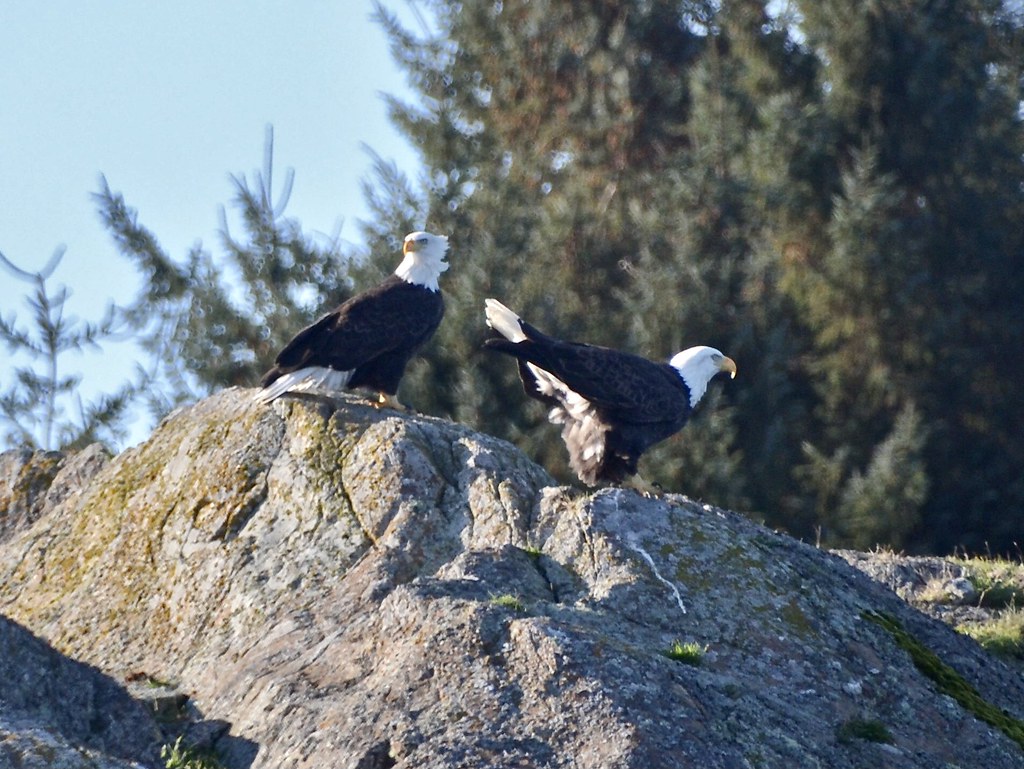 November 2015. Mrs E lightening her load prior to takeoff.
November 2015. Mrs E lightening her load prior to takeoff.
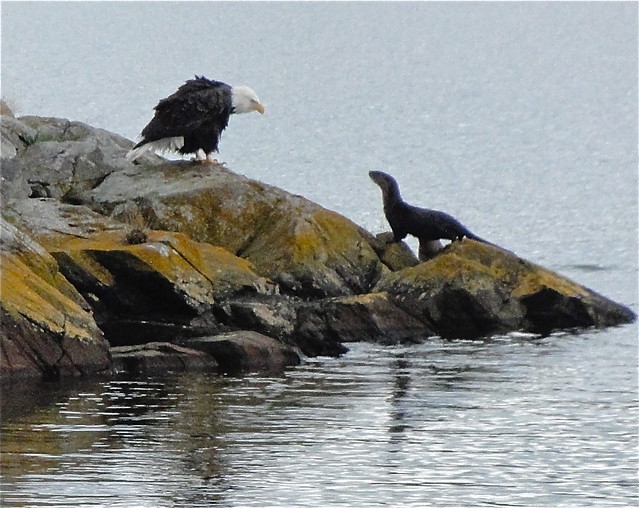 October 2012. Eagle sez to otters Don’t even think about coming out onto my rock
October 2012. Eagle sez to otters Don’t even think about coming out onto my rock
I was doing some organizing of photos earlier this week clearing out my “temporary” folder, and realized it was just cluttered with eagle photos (in this diary, “eagle” will mean “Bald eagle” aka Haliaeetus leucocephalus, since Golden eagles are not found in these parts except very rarely). In moving the pictures into their permanent folder, it occurred to me that posting some of these photos as a Dawn Chorus might be enjoyable for folks who don’t see eagles so often.
A very comprehensive source of information about Washington Bald eagles produced by WDFW can be found here: on State Status Report Washington State Status Report for the Bald Eagle for the Bald Eagle
🦅
Feeding
Bald eagles are generally thought of as fish predators, and while they will swoop down to the water’s surface to snatch a fish, they are not nearly as efficient at that as Ospreys, and will go for seabirds as often as fish around here. Bald eagles are considered “fish eagles” and will hunt for fish whenever they can, but they are very opportunistic feeders when fish are in short supply.
Overall, according to a review of studies cited in Birds of North America (Diet and Feeding) on average the diet of eagles is about half fish, half birds and mammals, with a few miscellaneous reptiles and crustaceans. In some localities and in some seasons, fish make up a considerable minority of their diet. Here in the islands eagles catch quite a few bunnies (European rabbits were introduced in settler days). They also eat a lot of birds. When I see a flock of gulls take flight and start screaming, I look up, knowing almost certainly there’s an eagle coming through. Ducks, shorebirds and herons also take flight. Alcids dive. Often an eagle just passes low without stooping and I have to wonder if they do that for the fun of it.
 June 2014. Unsuccessful fish stoop by a youngster.
June 2014. Unsuccessful fish stoop by a youngster.
.
.
Bald eagles are very diverse in diet and technique. Besides predation, they are skilled kleptoparasites, stealing from other birds on the wing and on the ground. Ospreys are a regular target. That may be why Ospreys appear so especially alert and watchful all around before stooping on a fish target. Once I photo’d an Osprey divebombing an eagle — maybe there was some history there, payback?
 June 2016. Osprey attacking eagle. The eagle flew off, pursued by the osprey
June 2016. Osprey attacking eagle. The eagle flew off, pursued by the osprey
A dramatic brouhaha on the beach one day in May 2017 pitted two master kleptoparasites against each other. I don’t really know who originally caught the unfortunate fish, but when I came upon the action, a dozen Glaucouswinged gulls were tearing apart a good-sized ling cod, a fish they’d be unlikely to have caught themselves. Then out of the sky an eagle came screaming down….the gulls scattered….the eagle snatched the remains of the fish and off it went. There was a second eagle around too but I couldn’t tell what the dynamic was between them.
 Dropping the fish under vocal protest
Dropping the fish under vocal protest
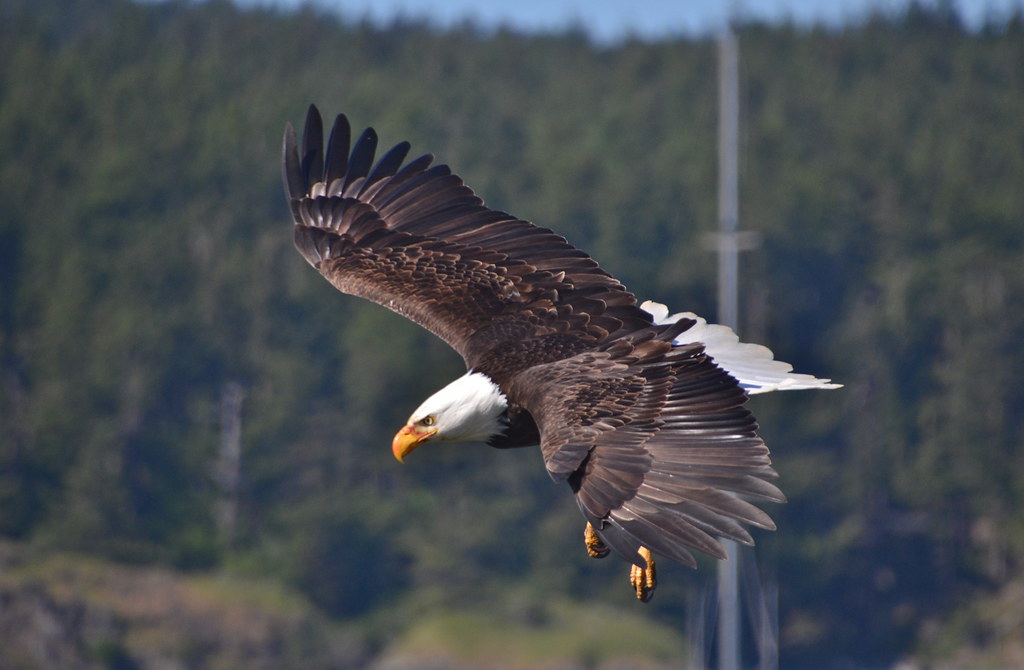 Laser focused
Laser focused
 Snatched it and flew off across the bay.
Snatched it and flew off across the bay.
A significant portion of Bald eagle food comes from carrion. Around here that means seals, livestock and roadkill. You have to be careful coming around a corner in case eagles, vultures or ravens are working a carcass. It takes some time for them to get airborne from a standing position.
The beach is also a fruitful location for carrion. Most often it’s seals. I’ve seen them working deer too. This particular carcass looks like raccoon, the fur looks too fluffy for seal.
 June 2014. Carrion is easy food.
June 2014. Carrion is easy food.
Pupping season (June) and lambing season (March-April) find eagles loitering around waiting for afterbirth or newborns. Lambing hasn’t quite started but a couple of weeks ago a ewe died suddenly in the field next door to where my garden helper lives. In no time, a dozen or more eagles were on it, along with a few early turkey vultures, plus the local ravens and crows. My helper watched the activity and reported a sad aspect of it: the ewe had been pregnant. S saw movement at one end of the carcass and thought at first it was scavengers busy there, but then realized the lamb fetus was still alive. But it wasn’t far enough along to survive if retrieved. So, like the ewe, it swiftly became converted into eagle. In a few days the carcass was nothing but wool and bones.
 February 2021. Eagles working a ewe carcass
February 2021. Eagles working a ewe carcass
🦅
Bathing
Eagles groom and bathe like all birds do. They prefer fresh water if available. A winter puddle next to the road made a perfect eagle bath and one day gave me a good look at a youngster having a nice long session (I pulled over for that!). It completely wetted all its feathers, dunking, shaking and flapping its wings. Then the eagle waded out onto dry ground fluffing it’s wings for a bit before flying off. I gather it went somewhere safer to groom.
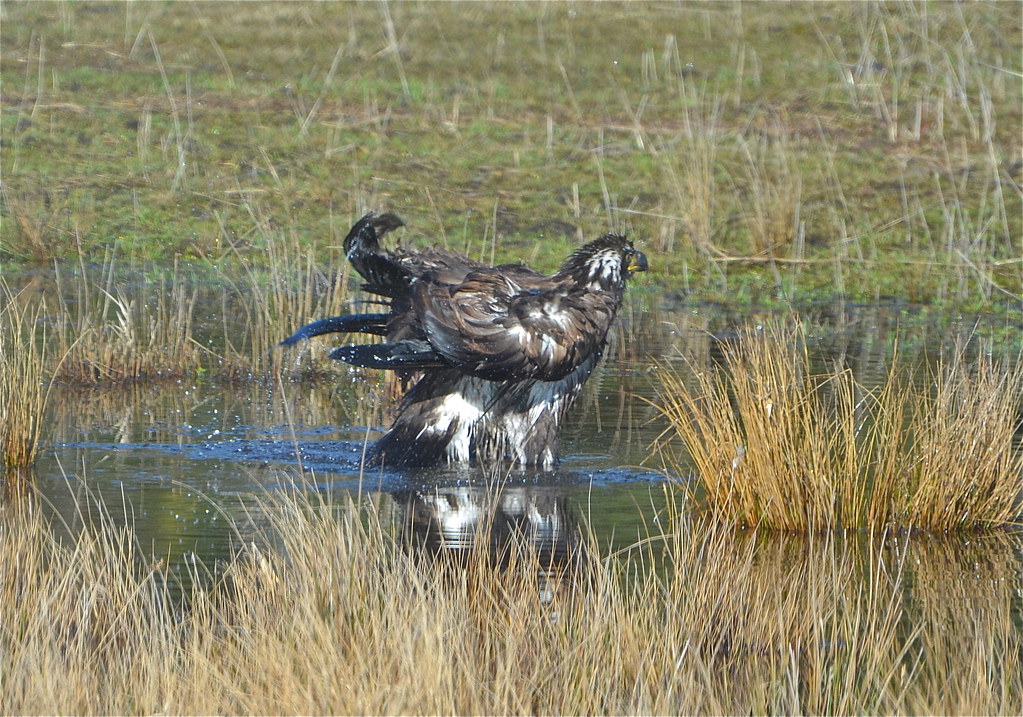 January 2015
January 2015
 January 2015
January 2015
🦅
Eagles through the year
Due to the abundance of various food in this area, we have many nesting pairs of eagles. Most nests are within a half mile of the seashore, which means primarily private wealthy waterfront property in this county, but there are some visible to the rest of us. Our local eagles lay eggs in March which hatch in April. Juveniles spend three months tended to by parents, fledging in July.
In 2018 I was lucky enough to watch a nesting pair raise one eaglet. After that year they abandoned the nest unfortunately. The tree has looked pretty flimsy for years.
 June 2018. Begging for food
June 2018. Begging for food
 July 2018. Branching.
July 2018. Branching.
In early fall, many of our local eagles migrate to mainland Washington and British Columbia rivers to feast on spawned out salmon. Fall is the quiet season. A week or so may go by when I won’t see a single eagle. Then in late fall/early winter they return. At that same time many migrating eagles arrive from Canada and Alaska to take advantage of the better climate and forage in Washington over the winter. From January to March the eagle population triples — it’s a great time to see scads of eagles perched up on rocks offshore surveying the prospects.
 January 2021. Ten eagles there
January 2021. Ten eagles there
Resident paired adults will refurbish their nests in January and February preparing for the next breeding season in late winter. Eagles are dedicated to their mates; it’s not uncommon to see pairs of eagles perched or flying together.
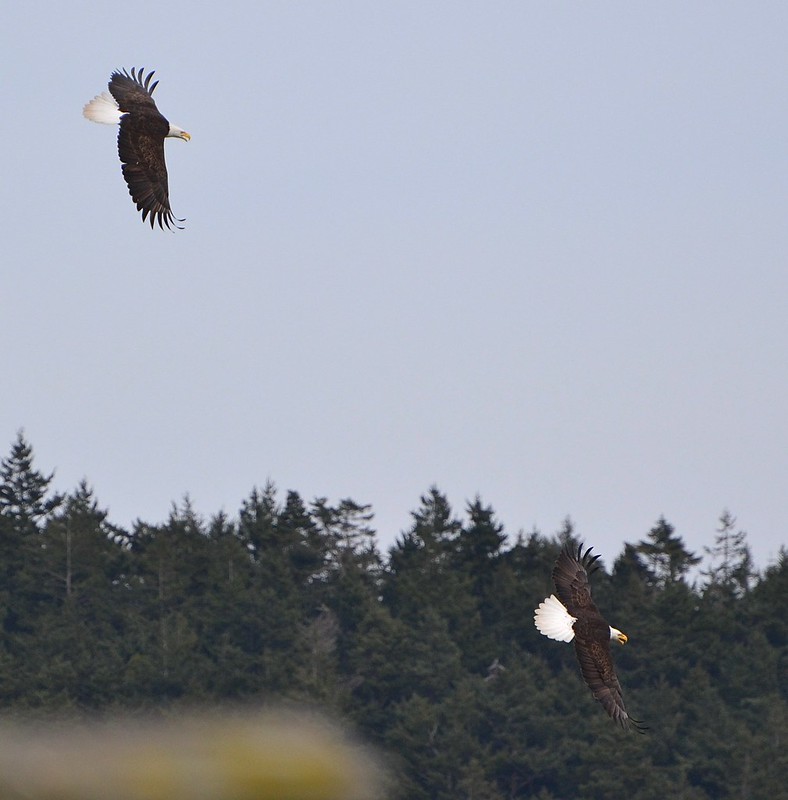 March 2014
March 2014
 February 2020
February 2020
However two eagles are not necessarily a pair. On one occasion I saw an eagle fly into the bay. It was immediately attacked by another, likely one of the pair who call this neighborhood their home. This was during nesting season.
 June 2014. Pursuit
June 2014. Pursuit
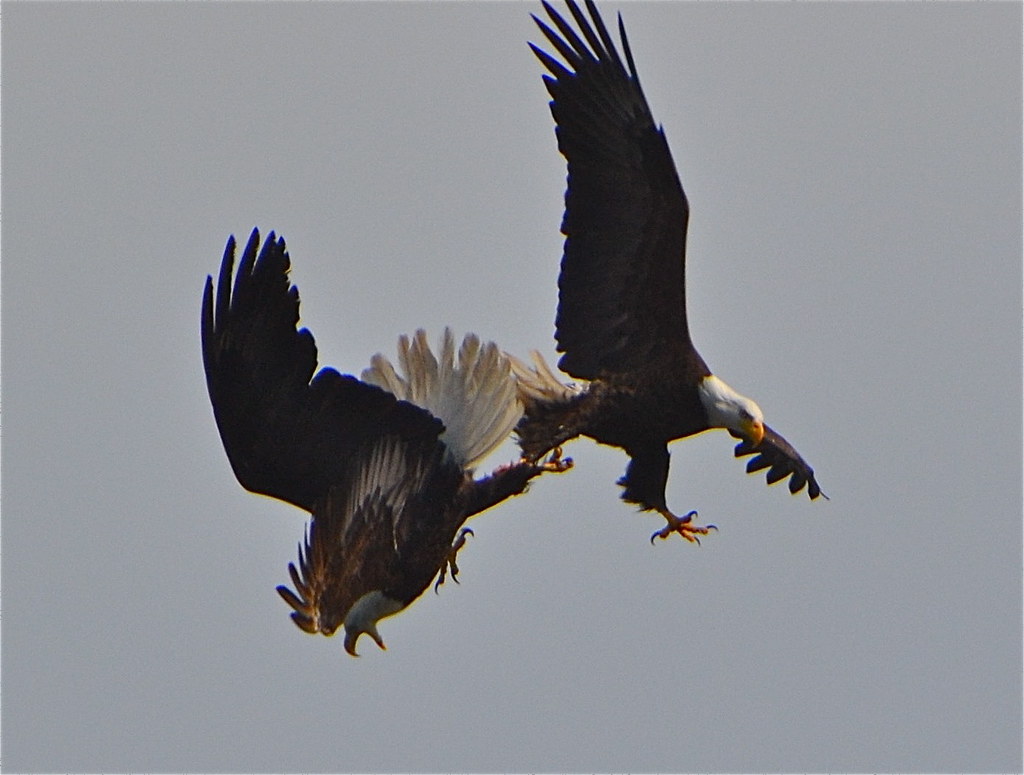 June 2014. Wrestling. This was not the talon-gripping sky-dancing courtship display.
June 2014. Wrestling. This was not the talon-gripping sky-dancing courtship display.
The following two eagles are adult and youngster. It was clear who dominated at this prime perching spot.
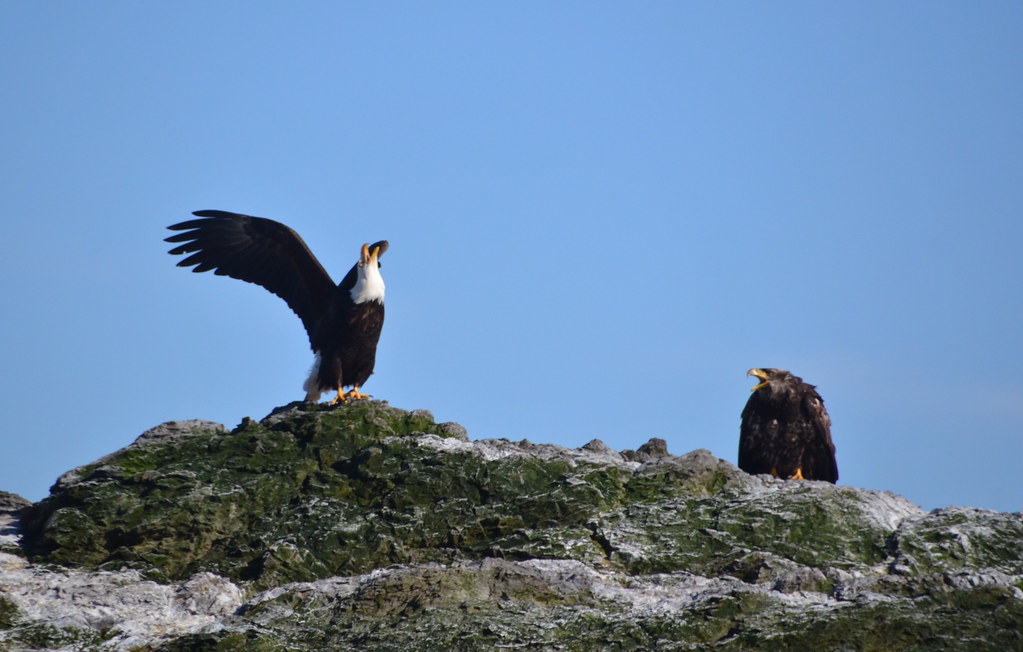 April 2017
April 2017
🦅
Telling age
Bald eagles can’t be mistaken for any other bird around here but figuring out who’s who amongst them has been an ongoing challenge for me. When a pair of adults are perched close together, the smaller male can be distinguished from the larger and fiercer-looking female, but alone it’s trickier.
Most eagles we see are adults. It takes 5 years for eagles to mature into their adult look, which they will have for the rest of their approx 30-year lifespan : bright white head and tail, yellow beak, light eyes. The plumage between their juvenile and adult stages changes in a more or less regular progression from dark brown to mottled to the adult pattern but it takes an expert to tell exactly where they are in development (we have a few here at the Chorus). The molting sequence isn’t straightforward and there are variations between individuals due to external factors.
In a general sense, you can tell roughly how old they are by the appearance of their head and tail. There are graphics showing those differences but they are copyrighted, so you’ll need to go to these links to see them. Avian Report has an article with photos describing the changes from juvenile (first year) through immature stages to adult. Mark McCollough’s article in The Wilson Bulletin (Molting Sequence and Aging of Bald Eagles) has more detail and includes graphics showing head and tail features at the different stages.
I have some WAG IDs for the following birds but I’d be happy to get feedback from birders who have more experience.
 March 2019. Adult, first year, 3rd year?
March 2019. Adult, first year, 3rd year?
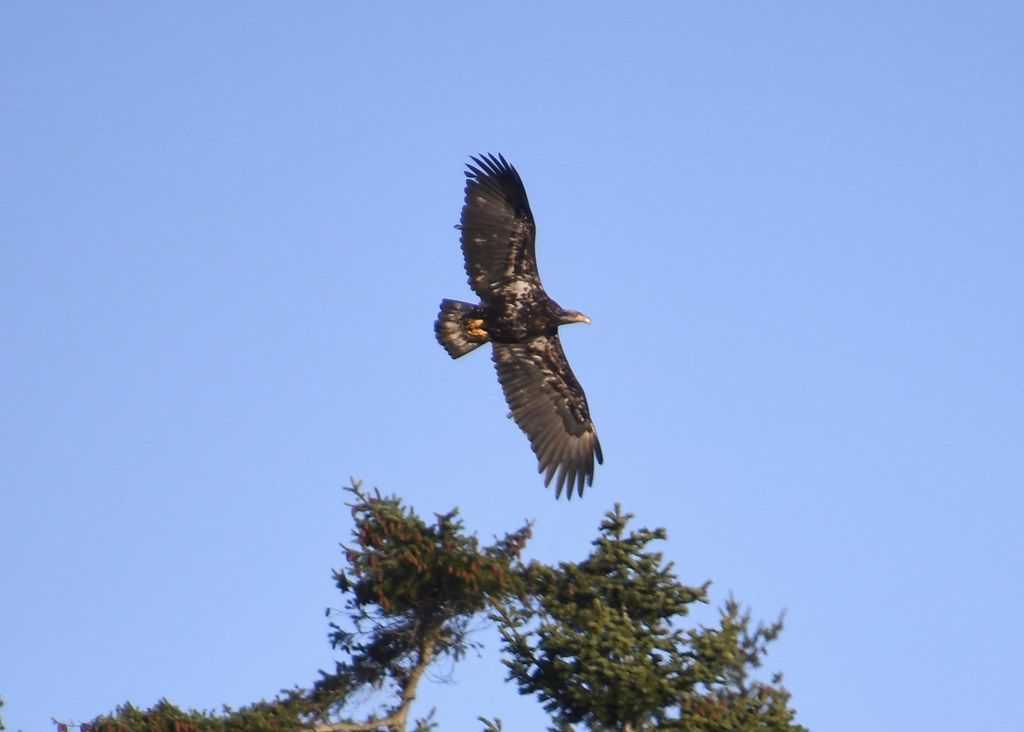 January 2020. 2nd or 3rd yr?
January 2020. 2nd or 3rd yr?
 March 2019. Back row: 4 yr, adult, 2 yr. Front row: 2 yr, adult, 1st year?
March 2019. Back row: 4 yr, adult, 2 yr. Front row: 2 yr, adult, 1st year?
 March 2014. 4 year?
March 2014. 4 year?
🦅
As my local eagles buckle down to a season of hard work of raising another generation, we can appreciate their magnificence in the comfort of the Dawn Chorus.
Your turn: what’s up this week in your birdy world?


